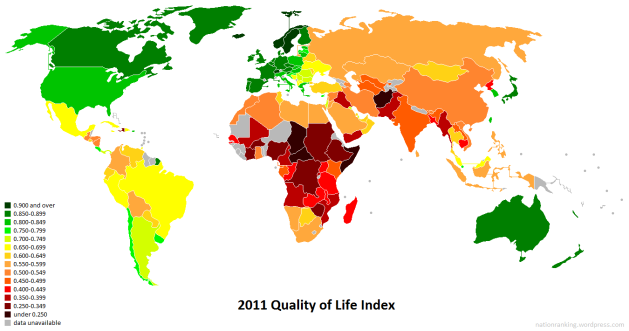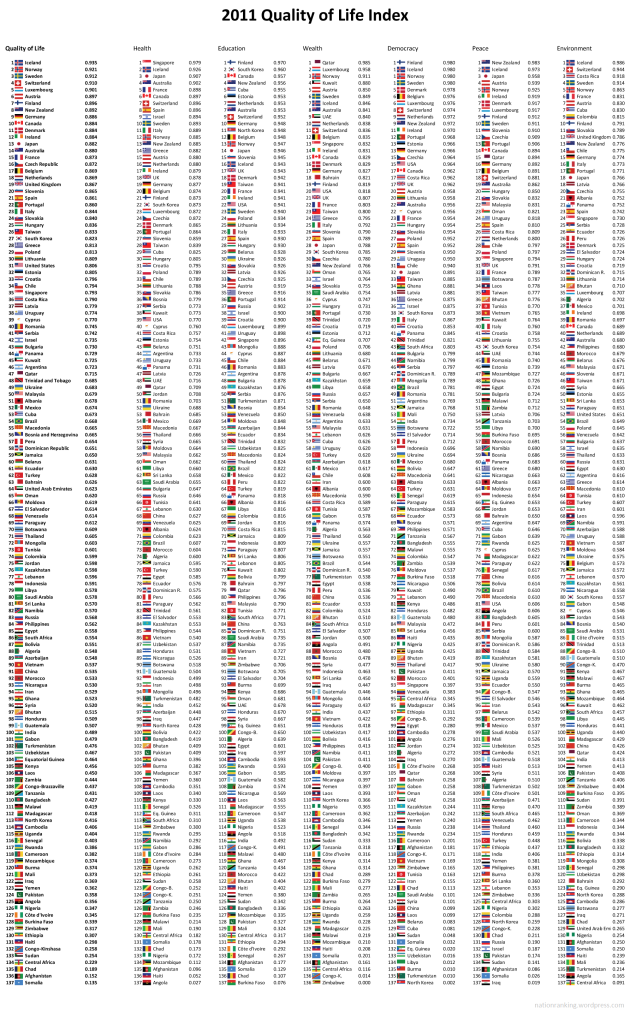2011 Quality of Life Index
06/03/2011
The Quality of Life Index (QLI) is an attempt to quantify a nation’s livability for its average inhabitant. It is a composite of six sub-indexes, each describing one of the elements which objectively influence the quality of life: health, education, wealth, democracy, peace and environment.
(click to enlarge)
Due to its debatable nature, the European Union does not appear in the list. The version including the European Union is added here:
_
QLI Methodology
The QLI is a composite of the following six sub-indexes. Each index is briefly explained, followed by its weighing in the QLI in parenthesis, and a breakdown into the numbers used to calculate it.
_
Health Index:
Health of the average person, access to and quality of health care (20%)
– Life expectancy at birth
– Mortality amenable to health care (when available)
– Infant mortality
– Access to health care
_
Education Index:
Education, access to and quality of education (20%)
– Adult literacy rate
– School life expectancy
– PISA results (when available)
_
Wealth Index:
Wealth of the average person (20%)
– GDP (PPP) per capita
– Gini coefficient of national income distribution
_
Democracy Index:
Individual rights and liberties (15%)
– Freedom House political rights index
– Freedom House civil liberties index
– Freedom House freedom of the press index
_
Peace Index:
Security from crime, repression and armed conflict (15%)
– Global Peace Index
_
Environment Index:
Quality and preservation of the environment (10%)
– Environmental Performance Index
For the full detailed methodology, click here.
About the QLI
Unlike other similar indexes, the QLI does not simply measure an average, but rather aims to represent the well-being of the average person. For instance, while most calculations use the GDP per capita to determine wealth, this can become severely inaccurate in a country where the majority of wealth is concentrated in the hands of just a few individuals, and thus does not improve the average person’s quality of life. For a more relevant result, a measure of wealth distribution becomes necessary. Therefore, the QLI’s Wealth Index combines the GDP per capita with the Gini coefficient, which measures income distribution, in order to assess the average individual’s actual wealth. Similar methods are used when applicable.
The QLI reflects the current situation, and does not attempt any predictions of the future. As such, it does not take into account dynamic factors such as growth, and only represents their visible results. The QLI also does not consider factors of debatable relevance, in particular factors which are only deemed relevant to the quality of life by certain ideologies, and does not use self-reported data. Finally, the QLI does not take into account unquantifiable elements which can subjectively affect the quality of life, such as culture or climate.
All indexes are based on the latest numbers available on 1 January 2011.



